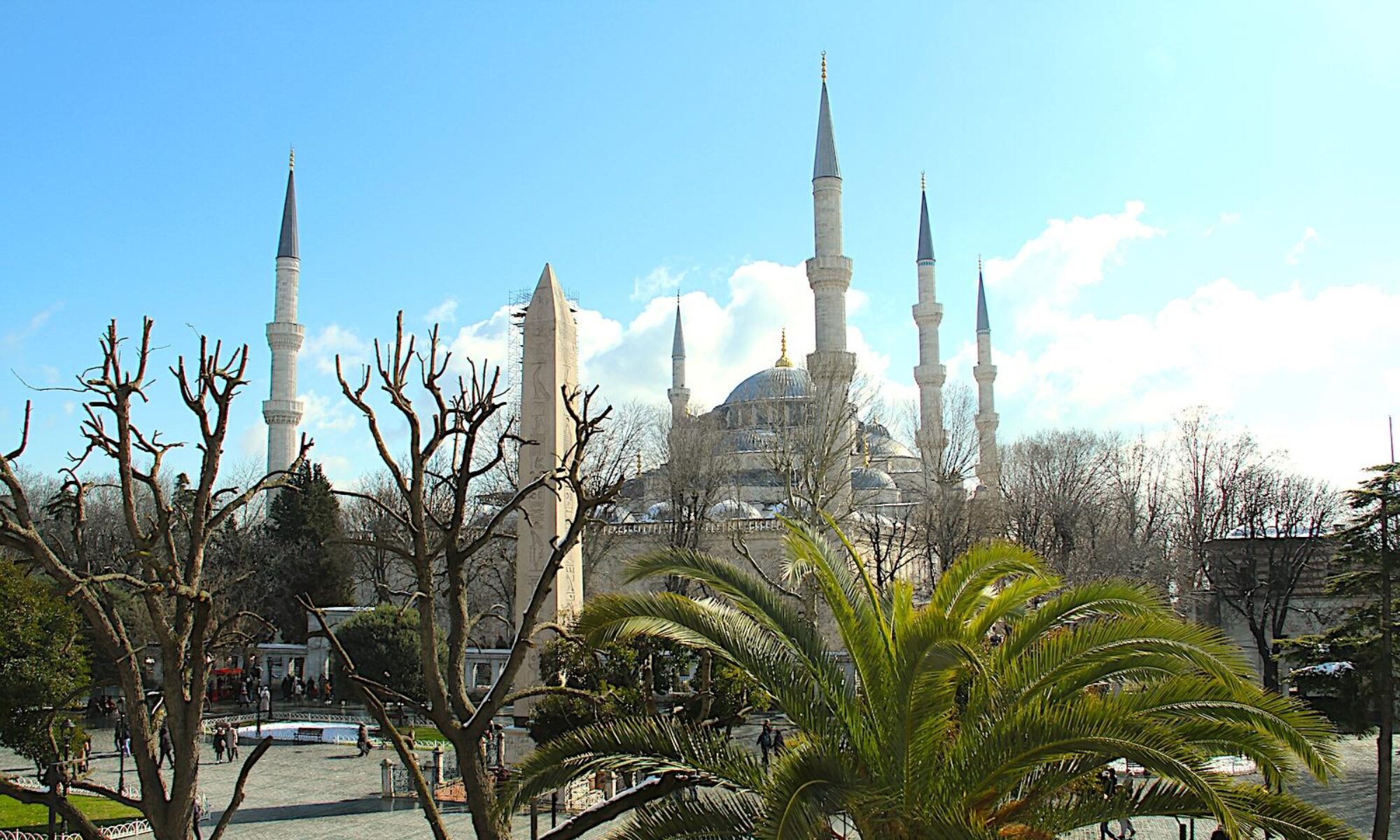The Istanbul Metro is a modern, rapidly expanding urban rail network that forms the backbone of Istanbul’s public transportation system. Designed to alleviate the city’s notorious traffic congestion, it offers an efficient way to navigate this sprawling metropolis, spanning Europe and Asia. The Istanbul metro consists of ten lines (seven on the European side and three on the Asian side) connecting key districts, business centres, residential areas, and transport hubs.

Istanbul Metro – Table of Contents
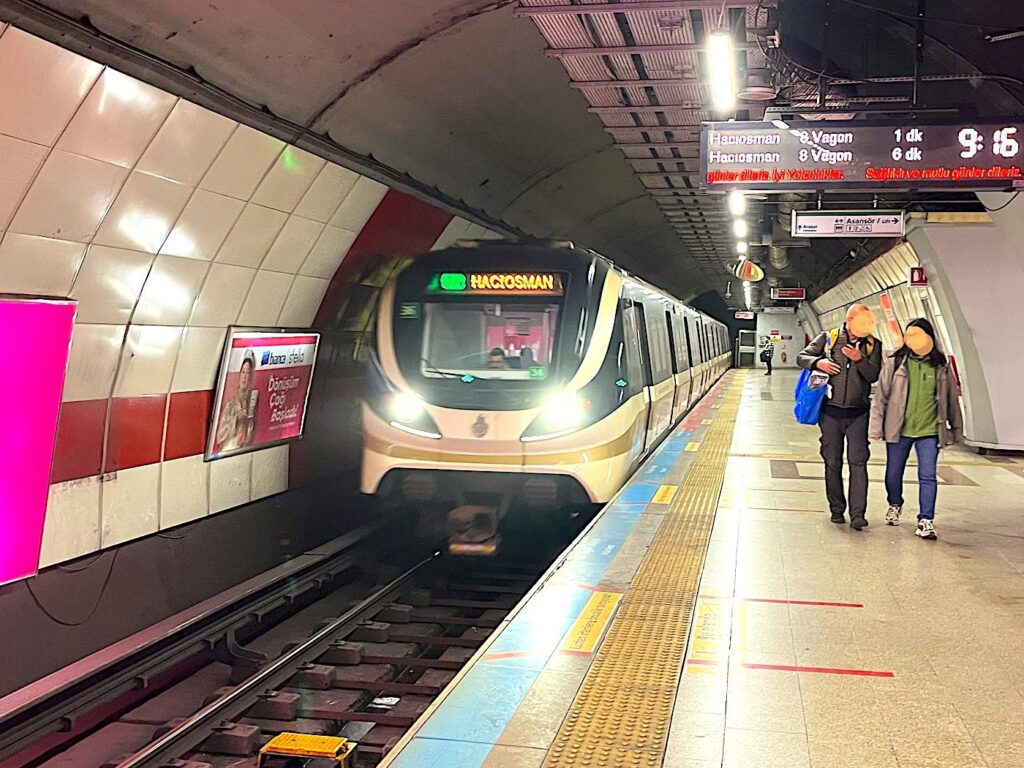

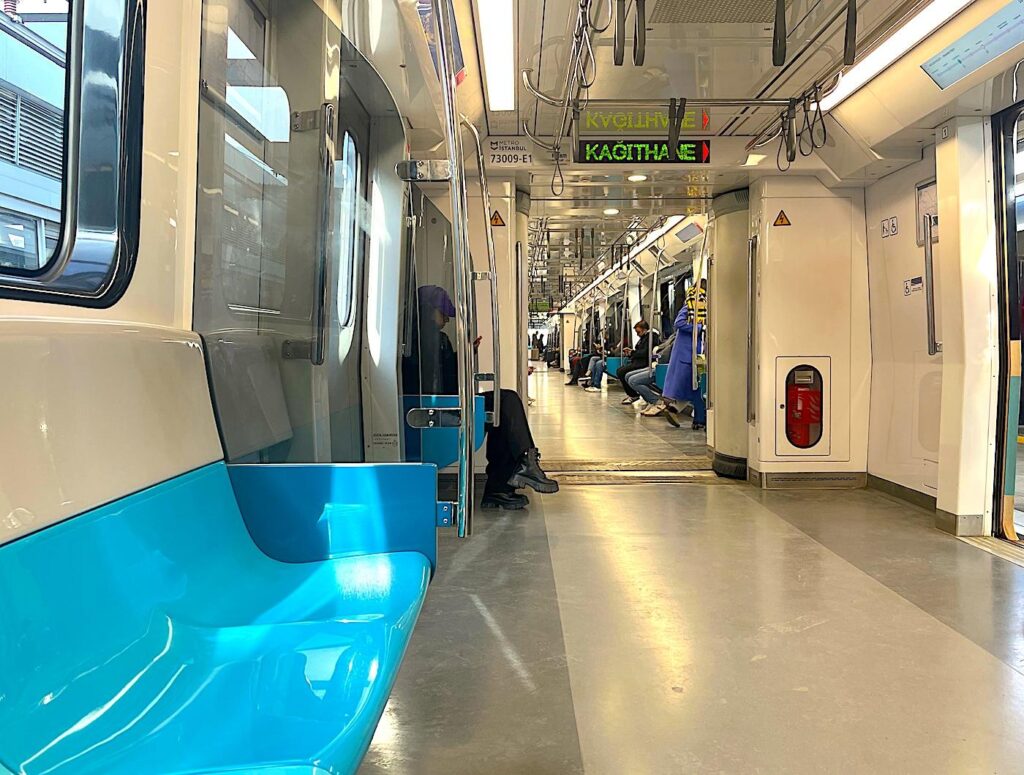

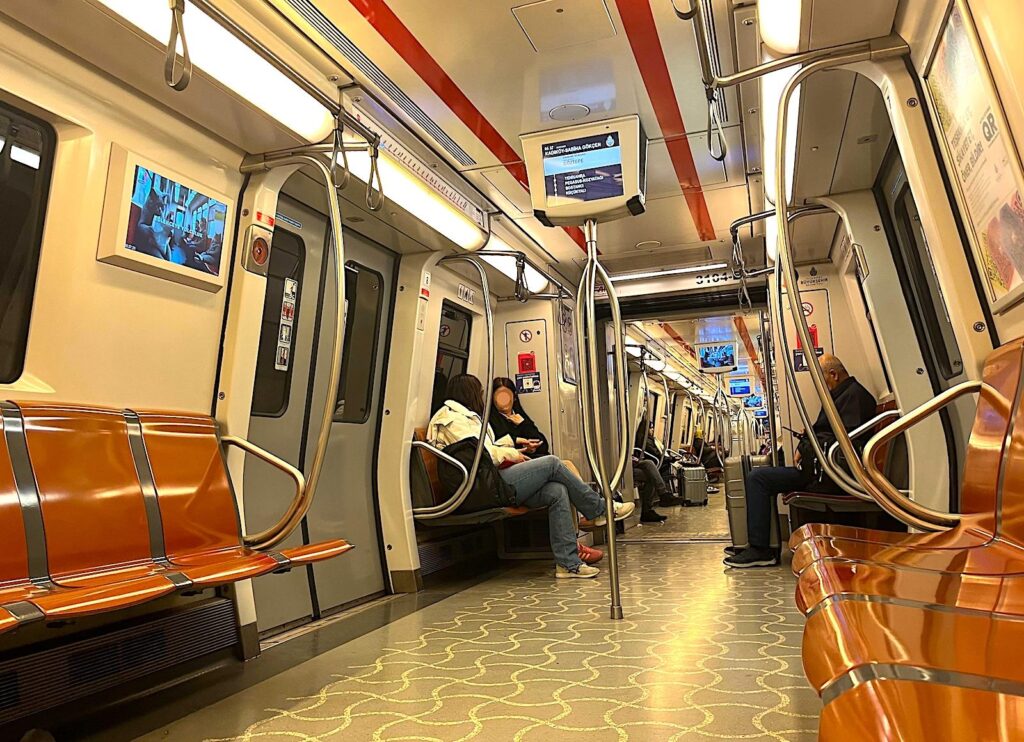
Istanbul Metro Lines
The most essential metro lines for tourists are M2, M11 and M4. The M2 line, perhaps the most tourist-friendly, runs through central Istanbul with key stops like Taksim, Şişhane (near Galata Tower), and Haliç (Golden Horn).
Key stops along the M2 line include Yenikapı, which connects the Marmaray and M1 lines, making it a central transport hub. Vezneciler is near the historic Süleymaniye Mosque and Istanbul University, while Şişhane provides easy access to the lively Galata district and Galata Tower. Taksim is a central stop near Istiklal Street, Gezi Park, and the Republic Monument, offering a gateway to the heart of modern Istanbul. Further north, Levent and Maslak are more business-oriented but offer upscale shopping and restaurants.
| M2 Metro Stop | Time (Minutes) | Transport Interchange | Places of Interest |
|---|---|---|---|
| Yenikapı | 0 | M1, Marmaray, T6 iDO ferries | Retail and Aksaray and Kumkapı historic district |
| Vezneciler | 3 | T1 | Süleymaniye Mosque, Beyazıt Square, Istanbul University, Grand Bazaar and Sultanahmet via T1 |
| Haliç | 5 | T5 | Golden Horn, Karaköy, Spice Market, Grand Bazaar, and Fener & Balat districts via T5 |
| Şişhane | 7 | T2, F2 | Galata Tower, Istiklal Street, art galleries, Beyoğlu historic neighbourhoods |
| Taksim | 10 | T2, F1 | Taksim Square, Republic Monument, Gezi Park, Istiklal Street, Beyoğlu historic neighbourhoods |
| Osmanbey | 12 | Bustling shopping district, Nişantaşı boutiques, cafés, the Military Museum, and Atatürk Museum | |
| Şişli – Mecidiyeköy | 15 | M7, Metrobus | Transport hub, business and commercial centre, Cevahir Shopping Mall |
| Gayrettepe | 18 | M11, Metrobus | Transport hub, business and commercial centre, Zorlu Centre Shopping and Entertainment Mall |
| Levent | 20 | M6 | Modern business and commercial centre with Kanyon, Özdilek, MetroCity shopping malls |
| 4. Levent | 23 | Business & residential | |
| Sanayi Mahallesi | 24 | M2 ext | Business & industrial |
| İTÜ – Ayazağa | 28 | Istanbul Technical University (ITU) campus, buses to Emirgan Park and İstinye on the Bosphorus coast | |
| Atatürk Oto Sanayi | 31 | Industrial | |
| Darüşşafaka | 33 | Residential | |
| Hacıosman | 36 | The north terminus of M2, buses to the Belgrad Forest parks and Sarıyer on the Bosphorus coast |
The M11 line connects the city’s primary airport, Istanbul Airport, to the centre. On the Asian side, the M4 line connects Kadıköy, a vibrant cultural and food district, with other residential neighbourhoods and Sabiha Gökçen Airport. Though not a metro line, the Marmaray, running beneath the Bosphorus, connects European and Asian sides and stops at major landmarks like Sirkeci and Üsküdar.
Istanbul Metro Airport Lines
The M11 metro line serves Istanbul Airport (IST), connecting it to the city with a high-speed, modern rail line. Officially known as the Gayrettepe–Istanbul Airport–Halkalı Metro Line, it currently runs between Gayrettepe and Arnavutköy Hastane via Istanbul Airport, with plans to extend to Halkalı (for Marmaray connections). The airport entrance to M11 is outside the main arrivals terminal, along a covered moving walkway and down a bank of lifts. Clear signage directs passengers toward the metro station.
This line offers a fast, traffic-free route into the city (24 minutes to Gayrettepe), although onward transfers are necessary to reach central districts like Taksim or Sultanahmet. Overseas passengers should obtain an Istanbulkart from machines or kiosks near the station entrance for seamless access to the metro and other transport. Trains typically operate from 06:00 to 00:00 and during the day are usually every 20 minutes.
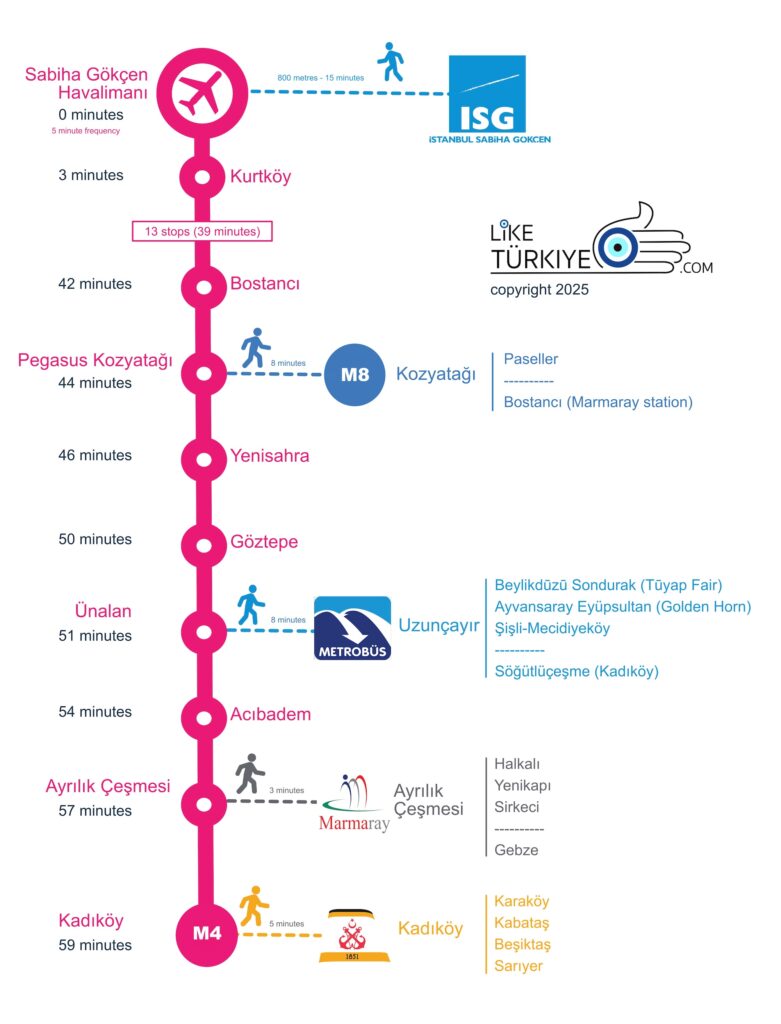
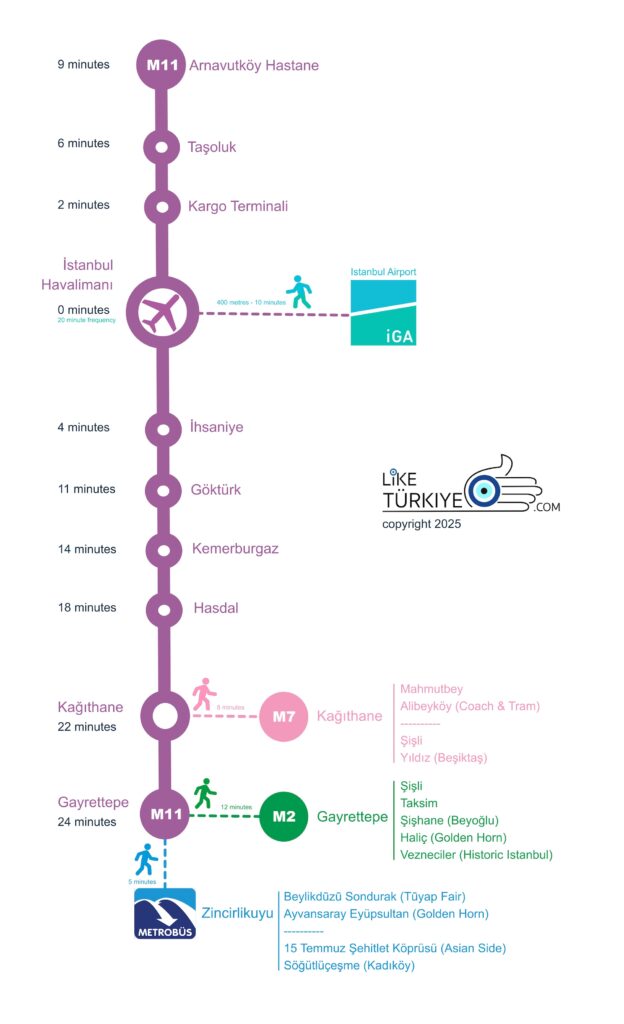
The M4 metro line serves Sabiha Gökçen Airport (SAW) and runs from Kadıköy on the Asian side to the airport, which was added to the line in 2022. The metro entrance at SAW is directly connected to the terminal via an underground walkway, making it easily accessible after baggage claim and customs. The ride from SAW to Kadıköy takes around 50 minutes, with connections to ferries and the Marmaray line at Ayrılık Çeşmesi for access to the European side.
International travellers arriving at IST or SAW must buy an Istanbulkart or a multi-use ticket from the ticket vending machines, for which there can be queues, especially if some machines are not functioning. Consider downloading a navigation app like “Moovit” or “Metro Istanbul” to check transfer options and schedules. M11 and M4 are clean, safe, and equipped with English signage, making them ideal for first-time visitors navigating Istanbul.
Istanbulkart
Istanbulkart, the city’s public transportation card, is the primary payment method. It can be purchased and recharged at kiosks, vending machines, or metro stations. Full details of the Istanbulkart can be accessed from the Istanbulkart official website (in English), which has details of fee pricing policies, links to download the Istanbulkart Apps, and the facility to top up cards. However, due to the complex login process, these activities are generally easier to execute on the ticket machines.
Once you have an Istanbulkart, tap it at the turnstiles or card readers at the metro stations’ gated entrances. The system automatically deducts the appropriate fare based on the route, and transfers between other public Istanbul transport (metro, tram, bus) within a specific time are discounted. If you don’t have an Istanbulkart, you can purchase it or single/multi-use tickets at ticket counters or machines at most metro station entrances.
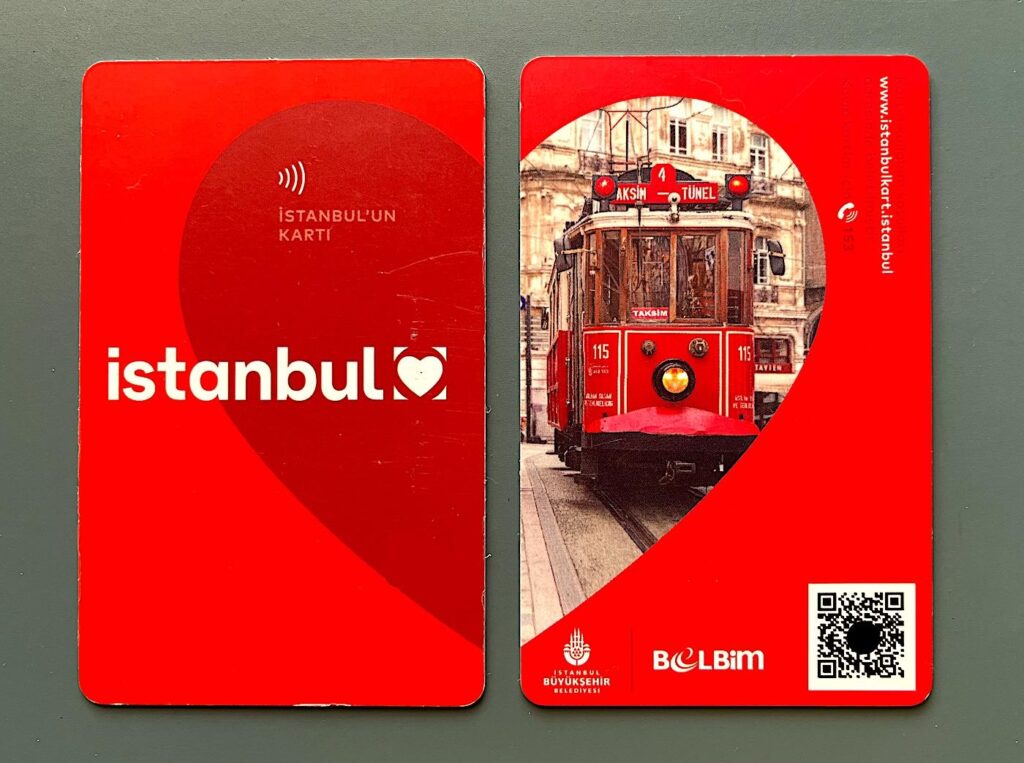
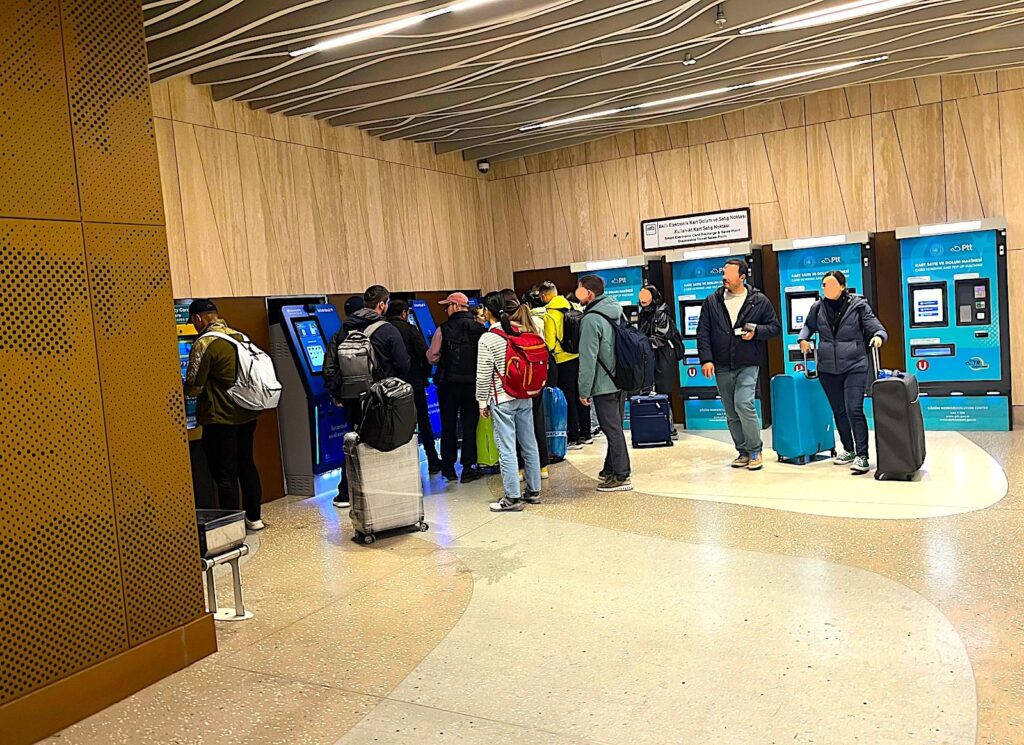
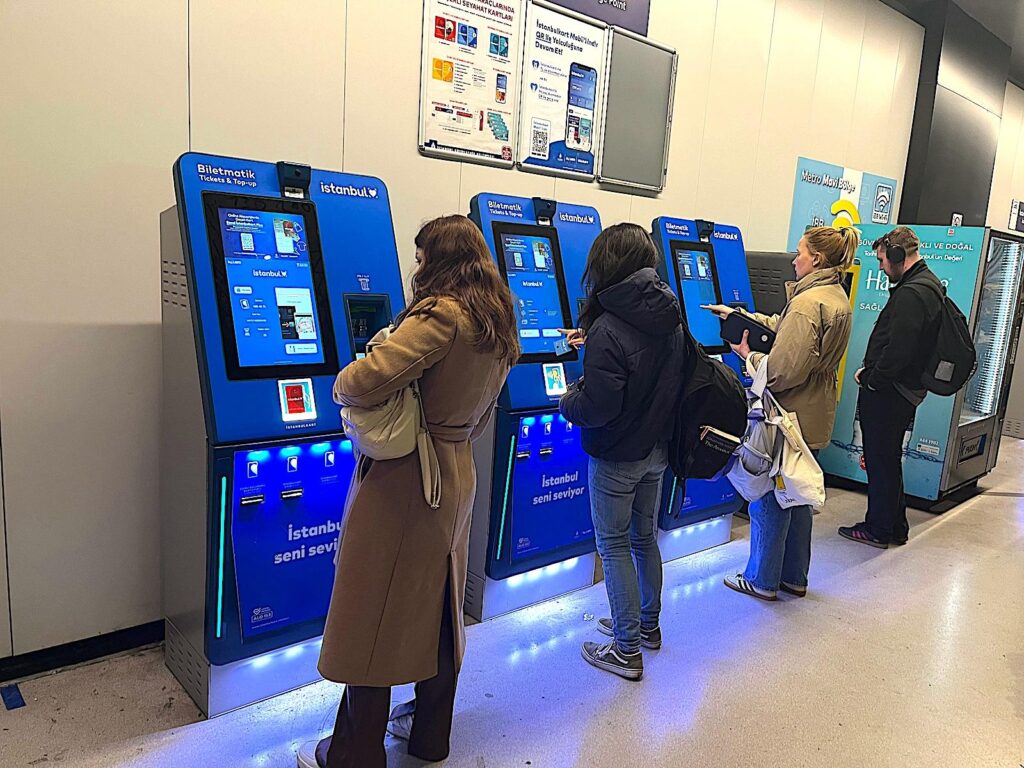
Istanbul Metro Fees
As of April 2025, the fee to buy an Istanbulkart (with zero balance) was the Turkish Lira equivalent of €3.00; the price of a standard single journey using the Istanbulkart was between €0.70 and €1.05, depending on the maximum length of the transport’s route. Subsequent transfers made within 120 minutes of the original tap are discounted at around 40-60%. Night (00:30-05:30) transportation is charged double the standard price. The general single-use tickets were €0.95, with multiple tickets up to a ten-pass ticket being €7.00.
With the Istanbulkart, passengers can benefit from transfer discounts within a 120-minute (2-hour) window after the first validation. During this period, if you switch from one form of public transport to another line or mode of transport, you pay a reduced fare for each subsequent ride, provided the transfer is within the allowed time, with a maximum of up to five transfers, each costing progressively less than the previous.
Fares are generally distance-based; the maximum distance/fare possible on the line you enter is deducted when you tap in at the start of your journey. You’re eligible for a partial fare refund if you do not travel the whole route. To get this credit back, tap your Istanbulkart on the fare refund machines (İade Cihazı) just past the exit gates at the station where you get off. The machine calculates the distance you travelled on Istanbul transport and instantly refunds the difference to your card balance.
Istanbul Metro Transfer Hubs
Many lines intersect at major transfer hubs like Yenikapı (M1A, M2, Marmaray), Taksim (M2, funicular to Kabataş), and Üsküdar (Marmaray and M5). The metro also links with other transit forms such as trams (especially T1, popular with tourists), funiculars, ferries, buses, and metrobuses, forming an integrated system covered by the Istanbulkart, a reloadable smart card. For example, tourists can take the M2 metro to Taksim, transfer via funicular to Kabataş, and board a ferry to the Princes’ Islands using the same card.
Istanbul Metro Subterranean Services
The subterranean services of the Istanbul Metro extend beyond simple transportation, offering various retail and convenience options to commuters and visitors alike. Many major metro stations, particularly interchange hubs such as Taksim, Şişli-Mecidiyeköy, and Yenikapı, feature small retail shops selling essentials like newspapers, mobile phone accessories, and personal care products. These stores cater to busy travellers who need to pick up items on the go. Some stations also include mini-markets or express branches of major supermarket chains, such as Migros Jet, making it easy for commuters to grab groceries or snacks at reasonable prices during their daily routine.

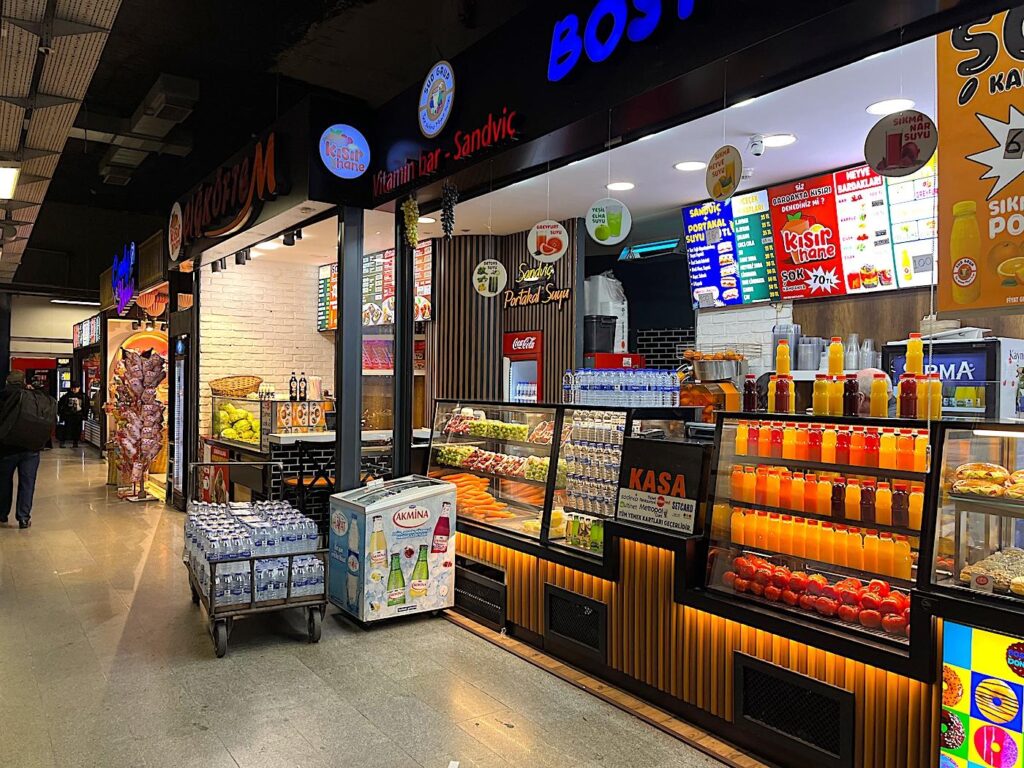

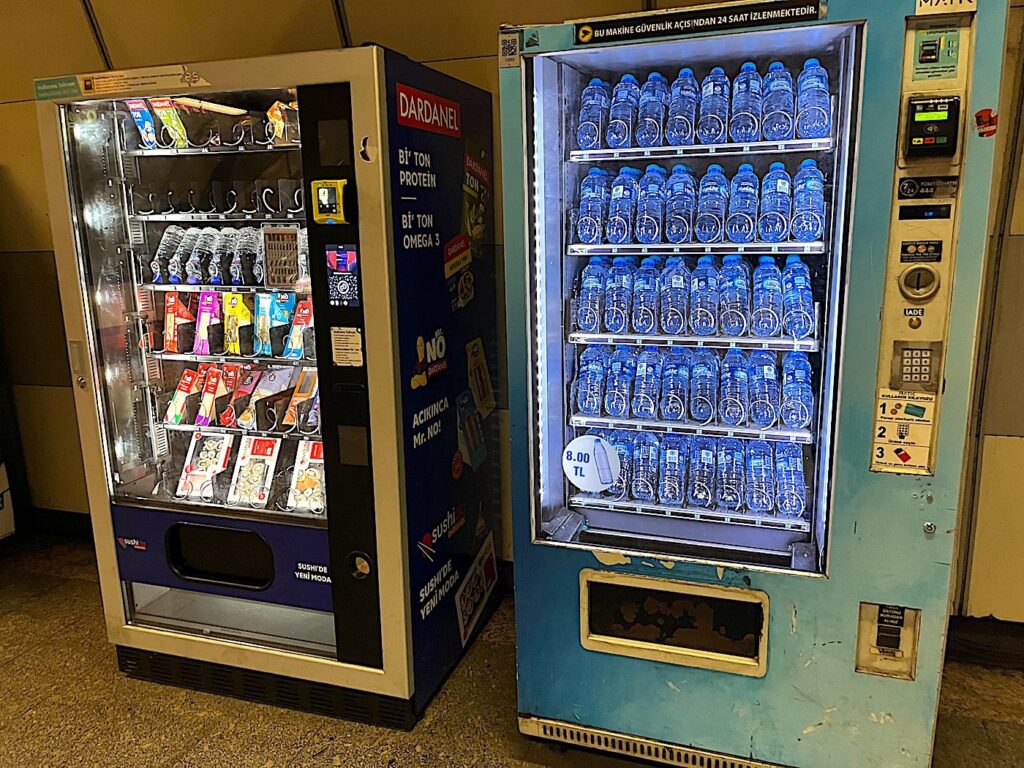
Fast food outlets and coffee shops are also integrated into the larger and more commercial stations. International chains like McDonald’s and Starbucks can be found in or directly adjacent to metro areas, alongside Turkish favourites such as Simit Sarayı and Börekçi stalls offering traditional baked goods. Vending machines are widely available on many platforms and station corridors, dispensing bottled water, soft drinks, snacks, and basic travel items.
Moreover, the Istanbul Metro offers direct underground connections to some of the city’s busiest shopping centres. Notable examples include the link from the Levent station to Kanyon and ÖzdilekPark malls, and the Şişli-Mecidiyeköy station’s access to Cevahir Shopping Mall, one of the largest in Europe. These connections allow passengers to transition seamlessly from transit to retail, promoting convenience and foot traffic for commercial spaces. Many stations also house ATMs from major banks, allowing riders to withdraw cash or complete basic transactions without leaving the metro premises.
Istanbul Metro Rules of Etiquette
The Istanbul Metro is a vital part of the city’s public transport system, and like any shared space, it operates best when passengers observe standard rules of etiquette. Riders are expected to prioritise seating for those who need it most: pregnant women, the elderly, people with disabilities, and those with small children. Designated priority seats near the doors are marked for this purpose, and it is both courteous and culturally expected to vacate them when necessary. Additionally, it’s considered impolite to block the doors during boarding and exiting; standing to the side and allowing passengers to exit first is a simple but meaningful gesture that keeps traffic flowing smoothly.
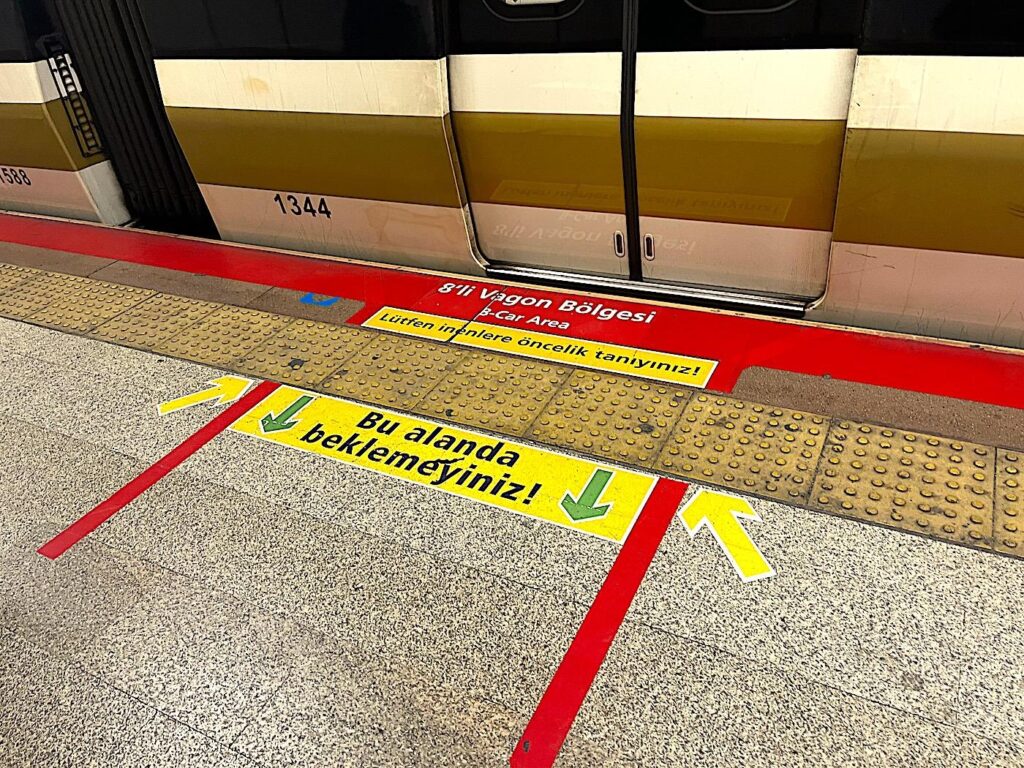
Istanbulites generally keep conversations at a moderate volume, and playing music or videos out loud is frowned upon. Headphones should be used, and phone calls should be kept brief and quiet. During peak hours, personal space becomes limited when carriages can be exceptionally crowded. Avoiding excessive movement, keeping backpacks or large bags in front of you, and being mindful not to push or lean on others helps everyone have a more comfortable ride. A polite apology if accidental contact occurs is also part of respectful behaviour. Eating and drinking, especially hot or strong-smelling foods, are discouraged inside the metro. Littering is strictly prohibited, and trash should be taken with you or disposed of in designated station bins.
History & Capacity of the Istanbul Metro
The history of Istanbul’s metro dates back to 1989, when the M1 line opened as Türkiye’s first modern underground system. Since then, the system has grown significantly, especially in the past two decades, in response to Istanbul’s population boom. As of 2025, the metro carries over 2 million passengers daily, with extensions underway, including automated lines like the M5 and M7. The newest lines are fully driverless, reflecting a trend toward greater automation and higher frequency. Capacity varies by line, with newer trains carrying around 1,000–1,500 passengers each.
Unlike other major cities like London, Paris, or New York, Istanbul’s metro system is relatively young but rapidly catching up in scale and technological advancement. While it may lack the historic charm of older systems, it offers modern amenities like air conditioning, real-time digital information, and accessibility features. Istanbul’s geography and landmark preservation challenges have slowed expansion in some areas. Still, ongoing investment and ambitious planning have made it one of the most dynamic transit systems in Europe and the Middle East.
See also: LikeTurkiye – Public Transport Network
